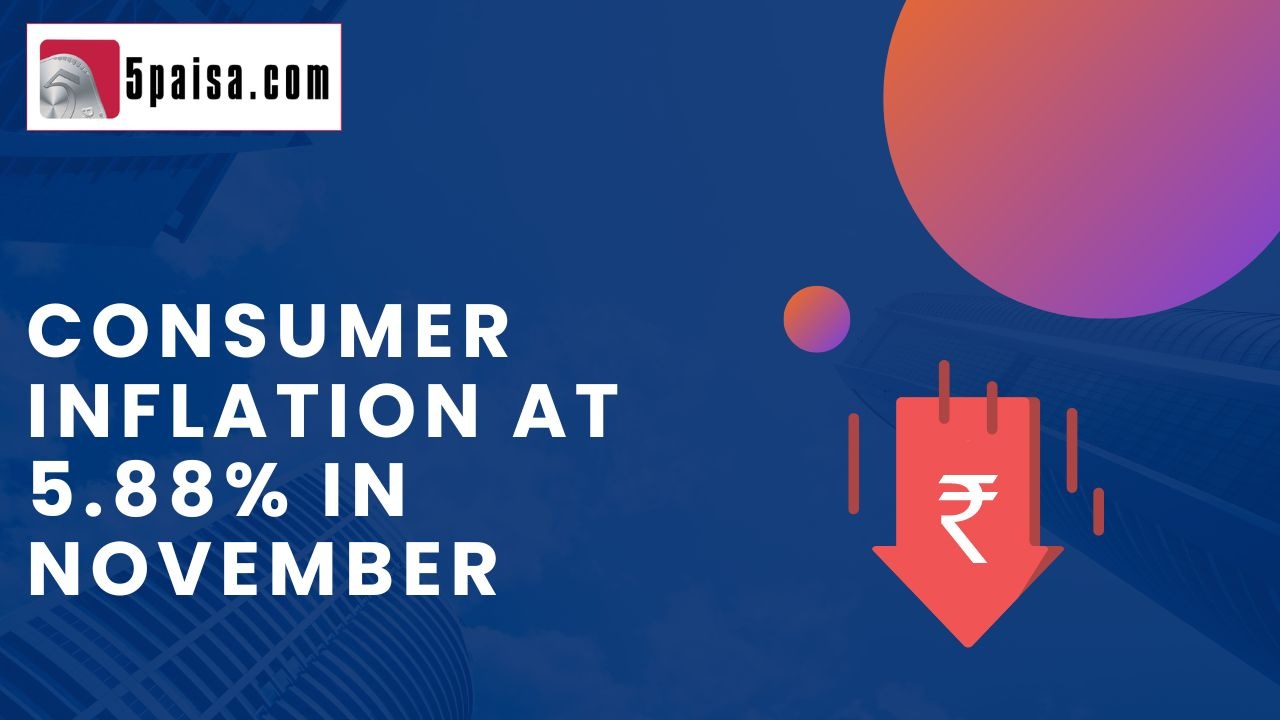Sobha Share Price Dips Amidst ₹865 Crore Equity Trade
Consumer Inflation falls sharply to 5.88% in November

Last Updated: 13th December 2022 - 05:06 pm
There was good news on the CPI Inflation (consumer inflation) front. For the month of November 2022, the CPI inflation fell sharply to 5.88%. What is interesting is that Bloomberg consensus has pegged the November inflation at 6.32% while the Reuters consensus had pegged the November inflation at 6.40%. The actual inflation was sharply lower than both the estimates, showing solid downward traction. To an extent that is a direct impact of the RBI hawkishness. Inflation fell by 89 bps over October and 153 bps over September. November may have been the 38th month of CPI inflation exceeding the 4% median target, but it was also the first time in 11 months that inflation was below tolerance limit of 6%.
|
Month |
CPI Inflation (%) |
Food Inflation (%) |
Core Inflation (%) |
|
Nov-21 |
4.91% |
1.87% |
6.08% |
|
Dec-21 |
5.59% |
4.05% |
6.01% |
|
Jan-22 |
6.01% |
5.43% |
5.95% |
|
Feb-22 |
6.07% |
5.85% |
5.99% |
|
Mar-22 |
6.95% |
7.68% |
6.32% |
|
Apr-22 |
7.79% |
8.38% |
6.97% |
|
May-22 |
7.04% |
7.97% |
6.08% |
|
Jun-22 |
7.01% |
7.75% |
5.96% |
|
Jul-22 |
6.71% |
6.75% |
6.01% |
|
Aug-22 |
7.00% |
7.62% |
5.90% |
|
Sep-22 |
7.41% |
8.60% |
6.10% |
|
Oct-22 |
6.77% |
7.01% |
5.90% |
|
Nov-22 |
5.88% |
4.67% |
6.00% |
Data Source: Ministry of Finance Estimates
A quick look at the table above shows that the sharp fall in inflation in the last two months can be largely attributed to the fall in food inflation. Even as Kharif has been lower than expected, early signals are of a bumper Rabi crop. Wheat sowing alone has shown 25% increase in acreage. With WPI falling by over 800 bps, it is expected that CPI inflation should also follow suit, sooner rather than later.
Key takeaways from the CPI inflation reading for November 2022
Here is what we read from the CPI inflation data for the month.
-
Despite the sharp fall in inflation in rural and urban India, the point of concern is that rural inflation is now much higher than urban inflation. The starkest example is that of cereals where out of the total inflation of 12.96%, rural cereals inflation was at 13.61%.
-
Just to buttress the point on rural inflation dominance; out of the headline inflation of 5.88% for November, rural inflation was 6.09% while urban India was 5.68%. The same applies to food inflation too. Headline food inflation was 4.67% but rural food inflation stood at 5.22% while urban food inflation was 3.69%.
-
While food inflation is sharply lower, core inflation showed a small bounce in November over October. The problem with core inflation is its structural nature, which makes it tougher to manage and regulate. Even the previous Economic Survey ahead of Budget 2022 underlined the imperative need to focus on core inflation above headline inflation.
-
Let us now turn to inflation and the food basket, which is the key component of consumer inflation. In terms of high protein foods; Meat and fish inflation rose higher to 3.87% while eggs bounced from negative to 4.86%. Oils and fats were subdued at -0.63% but milk inflation was high at 8.16% for November 2022.
-
Among the key drivers of the fall in inflation was fruits inflation, which tapered further to 2.62%, and the high-weight vegetable inflation, which dipped into negative at -8.08% in November 2022. This was offset to some extent by pulses inflation up at 3.15% and cereals inflation rising to 12.96% on the back of a weak Kharif crop.
Here is why the RBI should have greater clarity now
Now the RBI has two key data points and both are actually giving same signal to the central bank. Headline inflation has fallen sharply to 5.88% while IIP growth dipped to -4.0%, putting pressure on the overall GDP for next two quarters. The IIP slowdown is also due to global weakness and tepid exports, but the tightness has also contributed to most companies facing pressure on their profits. While the RBI may have curbed inflation, it has also put pressure on the growth engine of India Inc.
What then is the imperative for the RBI at this juncture? It is time for the RBI to act on the variables they control; i.e. cost of funds and domestic liquidity. By making the local conditions more favourable, it can mitigate the impact of global headwinds. RBI was right in adopting its anti-inflation stance since April 2022, but that may have not run its course with the repo rates already 110 bps above the pre-COVID rates. As MPC members like Ashima Goyal and Jayanth Varma have suggested, it may be time to talk growth over inflation.
The moral of the story is that the RBI has done its bit for toning down inflation expectations and ensuring price stability. Further adjustment will have to be on auto mode only. The reality is that the current situation of high input inflation, high interest rates and tight liquidity is not right if India dreams of being the fastest growing large economy in FY23. RBI has to lend a helping hand by making the monetary situation more comfortable.
Disclaimer: Investment/Trading in securities Market is subject to market risk, past performance is not a guarantee of future performance. The risk of loss in trading and investment in Securities markets including Equites and Derivatives can be substantial.
Trending on 5paisa
Discover more of what matters to you.
Indian Market Related Articles
 Tanushree Jaiswal
Tanushree Jaiswal




